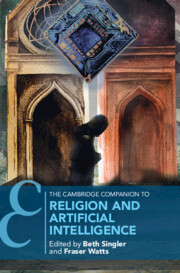Refine search
Actions for selected content:
48556 results in Computer Science
7 - What Will Robot Laws Look Like? Considering Code, AI and Human Laws
- from Part I - An Introduction to the Law, Policy, and Regulation for Human–Robot Interaction
-
-
- Book:
- The Cambridge Handbook of the Law, Policy, and Regulation for Human–Robot Interaction
- Published online:
- 07 December 2024
- Print publication:
- 21 November 2024, pp 115-133
-
- Chapter
- Export citation
34 - Robotic Torts
- from Part IV - Legal Challenges for Human–Robot Interaction
-
-
- Book:
- The Cambridge Handbook of the Law, Policy, and Regulation for Human–Robot Interaction
- Published online:
- 07 December 2024
- Print publication:
- 21 November 2024, pp 607-620
-
- Chapter
- Export citation
7 - Statistical Analysis
- from Part II - Evaluation for Classification
-
- Book:
- Machine Learning Evaluation
- Published online:
- 07 November 2024
- Print publication:
- 21 November 2024, pp 154-208
-
- Chapter
- Export citation
31 - Racialization and Bias toward Humanoids
- from Part III - Ethics, Culture, and Values Impacted by Human–Robot Interactions
-
-
- Book:
- The Cambridge Handbook of the Law, Policy, and Regulation for Human–Robot Interaction
- Published online:
- 07 December 2024
- Print publication:
- 21 November 2024, pp 556-572
-
- Chapter
- Export citation
22 - Ethical, Legal, and Social Concerns in the Application of Social Robots in Religious Settings
- from Part III - Ethics, Culture, and Values Impacted by Human–Robot Interactions
-
-
- Book:
- The Cambridge Handbook of the Law, Policy, and Regulation for Human–Robot Interaction
- Published online:
- 07 December 2024
- Print publication:
- 21 November 2024, pp 421-433
-
- Chapter
- Export citation
38 - The First Amendment and Robots in the Virtual and Physical Worlds
- from Part IV - Legal Challenges for Human–Robot Interaction
-
-
- Book:
- The Cambridge Handbook of the Law, Policy, and Regulation for Human–Robot Interaction
- Published online:
- 07 December 2024
- Print publication:
- 21 November 2024, pp 675-701
-
- Chapter
- Export citation
Preface
-
- Book:
- Web3
- Published online:
- 21 November 2024
- Print publication:
- 21 November 2024, pp xix-xxiii
-
- Chapter
- Export citation
Frontmatter
-
- Book:
- Machine Learning Evaluation
- Published online:
- 07 November 2024
- Print publication:
- 21 November 2024, pp i-iv
-
- Chapter
- Export citation

The Cambridge Companion to Religion and Artificial Intelligence
-
- Published online:
- 20 November 2024
- Print publication:
- 21 November 2024
Designing toy prototypes: an exploration of how fidelity affects children’s feedback on prototypes
-
- Journal:
- Design Science / Volume 10 / 2024
- Published online by Cambridge University Press:
- 20 November 2024, e33
-
- Article
-
- You have access
- Open access
- HTML
- Export citation
A hierarchical deep reinforcement learning algorithm for typing with a dual-arm humanoid robot
-
- Journal:
- The Knowledge Engineering Review / Volume 39 / 2024
- Published online by Cambridge University Press:
- 20 November 2024, e7
-
- Article
-
- You have access
- Open access
- HTML
- Export citation
Long induced paths in expanders
- Part of
-
- Journal:
- Combinatorics, Probability and Computing / Volume 34 / Issue 2 / March 2025
- Published online by Cambridge University Press:
- 19 November 2024, pp. 276-282
-
- Article
-
- You have access
- Open access
- HTML
- Export citation
Noisy group testing via spatial coupling
- Part of
-
- Journal:
- Combinatorics, Probability and Computing / Volume 34 / Issue 2 / March 2025
- Published online by Cambridge University Press:
- 19 November 2024, pp. 210-258
-
- Article
-
- You have access
- Open access
- HTML
- Export citation
The category of iterative sets in homotopy type theory and univalent foundations
-
- Journal:
- Mathematical Structures in Computer Science / Volume 34 / Issue 9 / October 2024
- Published online by Cambridge University Press:
- 19 November 2024, pp. 945-970
-
- Article
-
- You have access
- Open access
- HTML
- Export citation
FSBrick: an information model for representing fault-symptom relationships in heating, ventilation, and air conditioning systems
- Part of
-
- Journal:
- Data-Centric Engineering / Volume 5 / 2024
- Published online by Cambridge University Press:
- 18 November 2024, e33
-
- Article
-
- You have access
- Open access
- HTML
- Export citation
Increasing data sharing and use for social good: Lessons from Africa’s data-sharing practices during the COVID-19 response
-
- Journal:
- Data & Policy / Volume 6 / 2024
- Published online by Cambridge University Press:
- 18 November 2024, e53
-
- Article
-
- You have access
- Open access
- HTML
- Export citation
Robot hybrid inverse dynamics model compensation method based on the BLL residual prediction algorithm
-
- Article
-
- You have access
- Open access
- HTML
- Export citation
Developing a data analytics toolbox for data-driven product planning: a review and survey methodology
-
- Article
-
- You have access
- Open access
- HTML
- Export citation
















